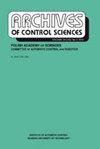Global path planning for multiple AUVs using GWO
IF 1.1
4区 计算机科学
Q4 AUTOMATION & CONTROL SYSTEMS
引用次数: 13
Abstract
In global path planning (GPP), an autonomous underwater vehicle (AUV) tracks a predefined path. The main objective of GPP is to generate a collision free sub-optimal path with minimum path cost. The path is defined as a set of segments, passing through selected nodes known as waypoints. For smooth planar motion, the path cost is a function of the path length, the threat cost and the cost of diving. Path length is the total distance travelled from start to end point, threat cost is the penalty of collision with the obstacle and cost of diving is the energy expanse for diving deeper in ocean. This paper addresses the GPP problem for multiple AUVs in formation. Here, Grey Wolf Optimization (GWO) algorithm is used to find the suboptimal path for multiple AUVs in formation. The results obtained are compared to the results of applying Genetic Algorithm (GA) to the same problem. GA concept is simple to understand, easy to implement and supports multi-objective optimization. It is robust to local minima and have wide applications in various fields of science, engineering and commerce. Hence, GA is used for this comparative study. The performance analysis is based on computational time, length of the path generated and the total path cost. The resultant path obtained using GWO is found to be better than GA in terms of path cost and processing time. Thus, GWO is used as the GPP algorithm for three AUVs in formation. The formation follows leader-follower topography. A sliding mode controller (SMC) is developed to minimize the tracking error based on local information while maintaining formation, as mild communication exists. The stability of the sliding surface is verified by Lyapunov stability analysis. With proper path planning, the path cost can be minimized as AUVs can reach their target in less time with less energy expanses. Thus, lower path cost leads to less expensive underwater missions. Global Path Planning (GPP), Grey Wolf Optimization(GWO), Sliding Mode Control (SMC), waypoints基于GWO的多auv全局路径规划
在全局路径规划(GPP)中,自主水下航行器(AUV)沿着预先设定的路径运行。GPP算法的主要目标是以最小的路径代价生成一条无碰撞的次优路径。路径被定义为一组分段,通过被称为路径点的选定节点。对于平滑平面运动,路径代价是路径长度、威胁代价和俯冲代价的函数。路径长度是从起点到终点的总距离,威胁代价是与障碍物碰撞的代价,潜水代价是在海洋中更深潜水的能量膨胀。本文研究了多auv编队的GPP问题。本文采用灰狼优化(GWO)算法求解多auv编队的次优路径。并将所得结果与遗传算法的求解结果进行了比较。遗传算法的概念简单易懂,易于实现,并支持多目标优化。该方法对局部极小值具有鲁棒性,在科学、工程和商业等领域有着广泛的应用。因此,本文采用遗传算法进行比较研究。性能分析基于计算时间、生成的路径长度和总路径成本。结果表明,在路径成本和处理时间方面,GWO算法优于遗传算法。因此,本文将GWO算法作为编队中三个auv的GPP算法。该地层遵循先导-跟随地形。在存在轻度通信的情况下,设计了一种基于局部信息的滑模控制器(SMC),在保持队形的同时使跟踪误差最小化。通过李雅普诺夫稳定性分析验证了滑动面的稳定性。通过适当的路径规划,auv可以在更短的时间内以更少的能量扩展到达目标,从而最大限度地降低路径成本。因此,较低的路径成本导致较低的水下任务成本。全局路径规划(GPP),灰狼优化(GWO),滑模控制(SMC),航路点
本文章由计算机程序翻译,如有差异,请以英文原文为准。
求助全文
约1分钟内获得全文
求助全文
来源期刊

Archives of Control Sciences
Mathematics-Modeling and Simulation
CiteScore
2.40
自引率
33.30%
发文量
0
审稿时长
14 weeks
期刊介绍:
Archives of Control Sciences welcomes for consideration papers on topics of significance in broadly understood control science and related areas, including: basic control theory, optimal control, optimization methods, control of complex systems, mathematical modeling of dynamic and control systems, expert and decision support systems and diverse methods of knowledge modelling and representing uncertainty (by stochastic, set-valued, fuzzy or rough set methods, etc.), robotics and flexible manufacturing systems. Related areas that are covered include information technology, parallel and distributed computations, neural networks and mathematical biomedicine, mathematical economics, applied game theory, financial engineering, business informatics and other similar fields.
 求助内容:
求助内容: 应助结果提醒方式:
应助结果提醒方式:


